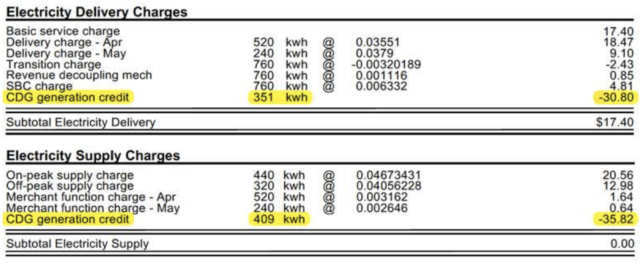A Guide to Your RG&E Bill with Solar
For members of the Huron or Sodus arrays.
The “CDG Value Stack Credit” represents the value of your CSA membership’s monthly production. This is applied as a negative dollar credit against your total supply and delivery charges.
Banked Solar Credit
In months when the value of your solar credit exceeds the sum of your supply and delivery charges, RG&E keeps track of any solar credit that is banked on your account. This does not appear on your bill, but you can call RG&E to find out the balance on your account.
CDG Value Stack Credit – Page 4


NET METER BILL
For members of the Harbec, Ontario, Webster, or Parma arrays.
- Period End Date – Last day of the billing period.
- Prior Excess CDG Generation – The number of unapplied kilowatt hours (kwh) carried forward from prior
months.
- Current CDG Generation – The number of kwh received from the CSA for the current billing period.
- CDG Generation Applied – The number of kwh applied to the current bill’s electric delivery and supply
charges.
- Remaining CDG Generation – The number of kwh available to apply to future bills (Prior Excess Generation
+ Current CDG Generation – CDG Generation Applied = Remaining CDG Generation). These credits carry over indefinitely. The only time excess credits will be forfeited is if you leave the CSA program or utility service area.
- CDG generation credit – represents a portion of your allocated solar credits that are applied to supply and delivery charges.
CDG Summary – Page 3


Electricity Delivery & Supply Charges – Page 3


If you have an ESCO, the CDG generation credit will appear under “Miscellaneous Charges” on page 4.
For example, this customer received 1,398 kwh of solar credit in this billing cycle. The customer used 760 kWh of electricity and did not need the full 1,398 kwh of solar generation. Therefore, 638 solar kwhs are carried forward to apply to future bills.
Frequently Asked Questions (For Value Stack and Net Metered Bills)
Any kWh electricity supply and delivery charges can be covered by CDG credits, except for the “Basic Service Charge” and any taxes and surcharges.
Your membership awards you the credits from your share of the energy production based on your membership level. Your bills to SunCommon are consistent each month but your monthly credits vary due to the time of year and length of day. For example, you will see higher credits in the summer’s longer days, with a monetary value higher than your monthly CSA membership payment. [Note: Excess credit gets added to your “Remaining CDG Credit” bank and does not have an assigned dollar value until it is applied to your electric charges.] However, during the winter’s shorter days, your solar credits may dip below this payment. For the spring, summer, and fall, credit overages should carry forward to help offset the lower production in winter.
At the top of page 3 of your bill, look for “Billed Usage” in the first chart.
Your billing cycle will not change. However, members of the same CSA will be billed at different times throughout the month based on RG&E’s meter read routes by location.
Keep in mind when reviewing your RG&E statements that the CSA is on a different billing cycle than your RG&E bills. While RG&E records past usage, your SunCommon payment goes towards future solar credits. Because of this, your usage period and the solar generation period will not perfectly align.
Even if you receive energy supply from an ESCO, the solar generation that is allocated to you is valued based on RG&E supply prices. Therefore, if RG&E’s prices are different than your ESCO’s prices, the difference will be reflected accordingly. This can be found on the ESCO portion of your RG&E bill. For example, if in a given month RG&E rates are below your ESCO rate, you will need more solar kWhs to offset your usage.
You are eligible to remain on budget billing. When you start receiving credits from the host, you will continue to be billed the same budget billing amount. The credit for solar generation will be reflected in the budget billing summary. Therefore, as your quarterly usage/solar credit history is built, the budget will be adjusted accordingly.
CCA stands for Community Choice Aggregation. It’s a way for your local elected officials to choose a third party company to supply your electricity instead of the utility. Your utility will continue to deliver your electricity. Most CCAs strive for some savings with renewable energy.
By participating in a SunCommon CSA, you are choosing to purchase your electricity from a specific local solar project. The local solar array will produce electricity and feed it directly into the utility grid so you can benefit from monthly credits reducing your electric bill. CCAs are managed by a third party administrator that work with several different Energy Service Companies and Distributed Energy Resource providers to aggregate a mix of renewable energy sources.
Yes, you can have both. The CCA may lower your overall monthly bill a little, by lowering the “supply” part of your bill. The CSA credits will appear as a separate line item on your bill, and will help offset the sum of the basic service charge, delivery charges, and CCA supply charges on your bill.
For any questions about your RG&E bill not related to solar credit, call RG&E at 800-743-2110 or email RGE_CDG@rge.com





